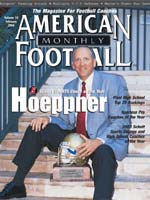AMERICAN FOOTBALL MONTHLY THE #1 RESOURCE FOR FOOTBALL COACHES
Article CategoriesAFM Magazine
|
Sharing Information Just Became Easier© More from this issueFor nearly a decade, thanks in many ways to publications like American Football Monthly, technology in football has become the norm rather than the exception. Every major football program, college or pro, has relied heavily on the latest forms of capturing, editing and exchanging video to enhance its ability to compete both on and off the field. Yet, very few football programs have the mega-million dollar budgets of major college football – much less that of the pros. However, new options of video exchange may have thousands of high school and small colleges enjoying some of the same benefits, such as quality, efficiency and reliability, as their deep-pocketed brethren. Many coaches are becoming familiar with several different means of exchanging video data, such as Internet s....The full article can only be seen by subscribers. Subscribe today!
|
|
|||||||
| HOME |
MAGAZINE |
SUBSCRIBE | ONLINE COLUMNISTS | COACHING VIDEOS |
Copyright 2025, AmericanFootballMonthly.com
All Rights Reserved





